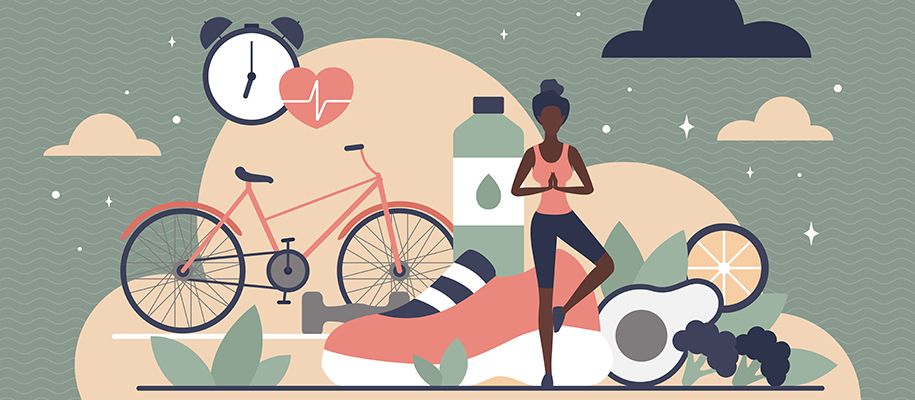Exercise is a powerful tool when it comes to boosting mental health. But what types of exercise are best for students constrained by time and space in dorm rooms to improve their mental well-being? Here are some simple yet effective options to consider for easing your way into working out. (And once you’ve mastered those, we’ve also included some exercises for when you’re ready to challenge yourself.)
Stretching routines
Stretching is an essential part of any exercise routine and an excellent way to improve flexibility, reduce stress, and prevent injuries. Incorporating stretching into your daily routine, especially if you lead a more sedentary lifestyle, can help you loosen up tight muscles, reduce tension, and increase your range of motion. There are many types of stretches, including static, dynamic, and proprioceptive neuromuscular facilitation (PNF).
- Static stretching involves holding a position for a designated period.
- Dynamic stretching involves moving through a specific range of motion.
- PNF stretching combines both static and dynamic stretching, usually incorporating resistance.
Stretching can be performed before or after a longer exercise routine or even during a break at work or school. Start with gentle neck and shoulder rolls to release tightness and tension in the upper body, then move on to the lower body to help improve flexibility in the hips, thighs, and calves. Some great lower body stretches include:
- Hamstring stretch: Sit on the floor with your legs straight out in front of you and gently reach for your toes.
- Quad stretch: Stand and lift one leg up behind you, and gently grab and hold your ankle, pulling your heel toward your body.
Remember to breathe slowly and focus on holding each stretch for 20–30 seconds, gradually working your way deeper into the stretch.
Breathing exercises
Breathing exercises can be done anywhere and anytime, making them a perfect addition to your daily routine. These simple exercises can help calm the mind, reduce stress levels, and increase oxygenation to the body. One way to incorporate them into your day is to set aside a few minutes each morning or before bed to do some deep breathing. You can also try doing them during the day to help ease anxiety and increase focus. Popular breathing exercises include:
- Diaphragmatic breathing or "belly breathing": Find a comfortable seated or lying position. Place one hand on your chest and the other on your stomach. As you inhale deeply through your nose, focus on expanding your stomach and feeling your hand rise. As you exhale through your mouth, feel your stomach deflate and your hand lower. Repeat this for a few minutes at a pace that feels comfortable for you.
- The "4-7-8" technique: To do this exercise, sit comfortably with your back straight. Inhale deeply through your nose for a count of four. Hold your breath for seven, then exhale slowly through your mouth for eight. Repeat this exercise for a few minutes, focusing on the rhythm of your breath.
In addition to reducing stress and increasing oxygenation, breathing exercises have been shown to improve sleep quality, regulate blood pressure, and even aid digestion. Find a breathing exercise that feels comfortable for you and make it a part of your daily routine. You may be surprised by the effects it can have on your overall health and well-being.
Related: Working Out Your Mental Health: 3 Benefits of Regular Exercise for Students
Desk stretches
College life often involves extended periods of sitting, which can adversely affect your health. However, incorporating simple exercises can help combat the sedentary nature of desk work. Even while sitting, there are several exercises you can do to engage your muscles and promote blood circulation.
- Seated leg raises: Extend one leg at a time and hold it in the air for a few seconds before switching. This exercise targets the quadriceps and can be performed discreetly without attracting much attention.
- Shoulder shrugs: This movement helps alleviate tension in the neck and shoulder area after prolonged sitting. Simply raise both shoulders toward your ears, hold for a few seconds, and relax. Repeat this motion several times as an effective way to reduce muscle stiffness and promote better upper-body posture.
- Seated forward bend: Begin by sitting tall on the edge of your chair with your feet flat on the floor. Take a deep breath, and as you exhale, slowly fold forward from your hips, reaching your hands toward the floor. Allow your head and neck to relax. Hold this stretch for 30 seconds while breathing deeply. This will stretch the lower back, hamstrings, and shoulders.
Listening to your body and adjusting these exercises to your comfort level is important. Additionally, taking regular breaks to stand up, stretch, and walk around can further enhance your overall well-being while working at a desk.
Bodyweight exercises
Bodyweight exercises are an excellent way for students living in dorm rooms to stay fit. With no equipment necessary, it’s an affordable and convenient way to tailor a workout to any fitness level, making them perfect for beginners and seasoned athletes. Bodyweight exercises improve strength, cardiovascular endurance, and flexibility. Here are some exercises you can do in your dorm:
- Squats: To help strengthen your legs and glutes, stand with your feet shoulder-width apart and bend your knees until your thighs are parallel to the floor. Return to the starting position and repeat for 10–15 reps.
- Push-ups: Work your chest, shoulders, and triceps with some basic push-ups. Make sure to practice good form and repeat only as long as is comfortable for you.
- Lunges: These will strengthen your legs and glutes while improving balance. Stand with your feet hip-width apart and step forward with one foot until both knees are bent at a 90-degree angle. Step back and alternate through 15 reps for each leg.
- Planks: Planking works the entire core, including your abs and lower back. Begin in a push-up position and lower your body until your forearms are resting on the floor, then hold your body in a straight line for however long is comfortable to you, building up to 30–60 seconds.
- Mountain climbers: This is a full-body exercise that works the legs, core, and upper body. Begin in a plank position, bring one knee toward your chest, then quickly switch legs. Keep alternating legs as fast as you can for 30–60 seconds.
Incorporating these exercises into a regular routine is easy because they can be done anywhere, making them a convenient option for students living in small spaces.
Related: How to Set Up an Effective Exercise Routine Living in a Dorm
When you’re ready for a challenge
If you want to take the next step in your exercise journey, try these more intense options to really work up a sweat.
Aerobic exercise
Aerobic exercise involves increasing your heart rate for a sustained period through things like jogging, cycling, and swimming. Regular aerobic exercise can help you feel more awake and alert throughout the day and boost your overall endurance levels. This can be especially helpful for students during long hours of studying and attending lectures. It can also help reduce symptoms of depression and anxiety, improve self-esteem, and even boost cognitive function. Aerobic exercise doesn't have to be complicated or require a gym membership. If you don’t feel like leaving your dorm to swim at the fitness center or bike around campus, you can incorporate aerobic activity in other ways, like doing calisthenics or following workout videos. Even simple activities such as brisk walking or jumping jacks can be effective, and dancing can be a fun alternative as well. To reap the benefits of aerobic exercise, aim for at least 30 minutes of moderate exercise each day. This can be broken up into smaller increments throughout the day if necessary.
Strength training
Strength training can reduce stress levels and provide a sense of accomplishment when performed regularly. And these exercises can easily be done without expensive equipment just by returning to and altering our bodyweight exercises. Squats can be boosted with cheap dumbbells. Planks can be held for longer periods or with increased weight resting on your back. For those looking to target the arms and shoulders, come back to your push-ups for more repetitions.
It’s important to remember that proper form is critical when performing strength training exercises. Start with lighter weights or just body weight and work your way up as you become stronger. And don’t forget to mix up your routine with different exercises to keep things exciting and challenging. With dedication and perseverance, strength training can become a valuable part of any college student’s daily life.
Related: 4 Easy Ways to Be More Active With a Hectic School Schedule
Yoga
Yoga is an ancient practice that originated in India but has since become a popular form of exercise and relaxation worldwide. Known for improving flexibility, strength, and balance, it consists of various poses, or asanas, designed to stretch and strengthen different parts of the body. Some of the most common poses include downward-facing dog, warrior, and tree pose. Each pose is typically held for several breaths, allowing the body to deepen into the stretch and release any tension. It can be practiced in a variety of settings, from studios to outdoor parks or even in the comfort of your own dorm room. There are also different styles, ranging from gentle and restorative to intense and challenging.
Yoga also has many mental health benefits, such as reducing stress and anxiety, improving focus and concentration, and promoting better sleep. Since it emphasizes the importance of mindfulness and meditation, practicing yoga can help you become more present and let go of any distracting thoughts or worries. If you're new to yoga, start with a beginner's class or tutorial to learn the correct form and avoid injury. As you become more comfortable, gradually increase the intensity and challenge yourself with more advanced poses.
HIIT exercises
High-Intensity Interval Training (HIIT) has gained significant popularity in recent years due to its effectiveness in maximizing fitness in minimal time. HIIT involves alternating between short bursts of intense exercise and brief recovery periods. This form of training helps improve cardiovascular fitness, reduce stress, promote fat-burning, and boost metabolism. With HIIT, individuals can achieve remarkable results in as little as 20 minutes per session, making it perfect for those with busy schedules. HIIT exercises are also versatile and include running, cycling, and bodyweight exercises that you can perform anywhere. This flexibility allows you to customize your workouts based on your personal preferences and available resources.
HIIT also causes excess post-exercise oxygen consumption (EPOC), or the "afterburn effect," which refers to increased metabolic rate and calorie expenditure that can last hours after a session. By incorporating HIIT exercises into your fitness regimen, you can reap the benefits of an efficient workout that keeps your body working hard long after you've finished. Incorporating HIIT into a fitness routine can provide a holistic approach to well-being by addressing both physical and mental health needs.
Related: 3 Easy Ways to Exercise in College (Without Hitting the Gym!)
Whichever exercise you choose, it's important to remember that consistency is key. Even just a few minutes of exercise each day can positively impact your physical and mental health. And don't forget to make time for balanced meals and rest in your daily routine as well. By caring for your mind and body, you'll be better equipped to handle the demands of college life.
Want more general tips on living your best life in college? Check out the other blogs and articles in our Student Life section.







